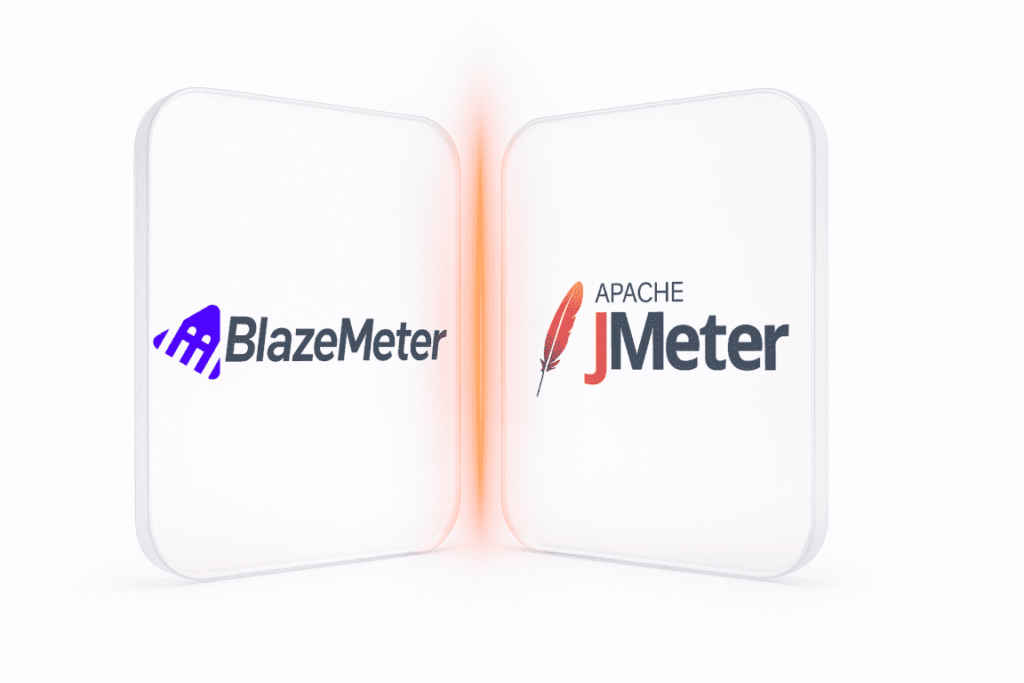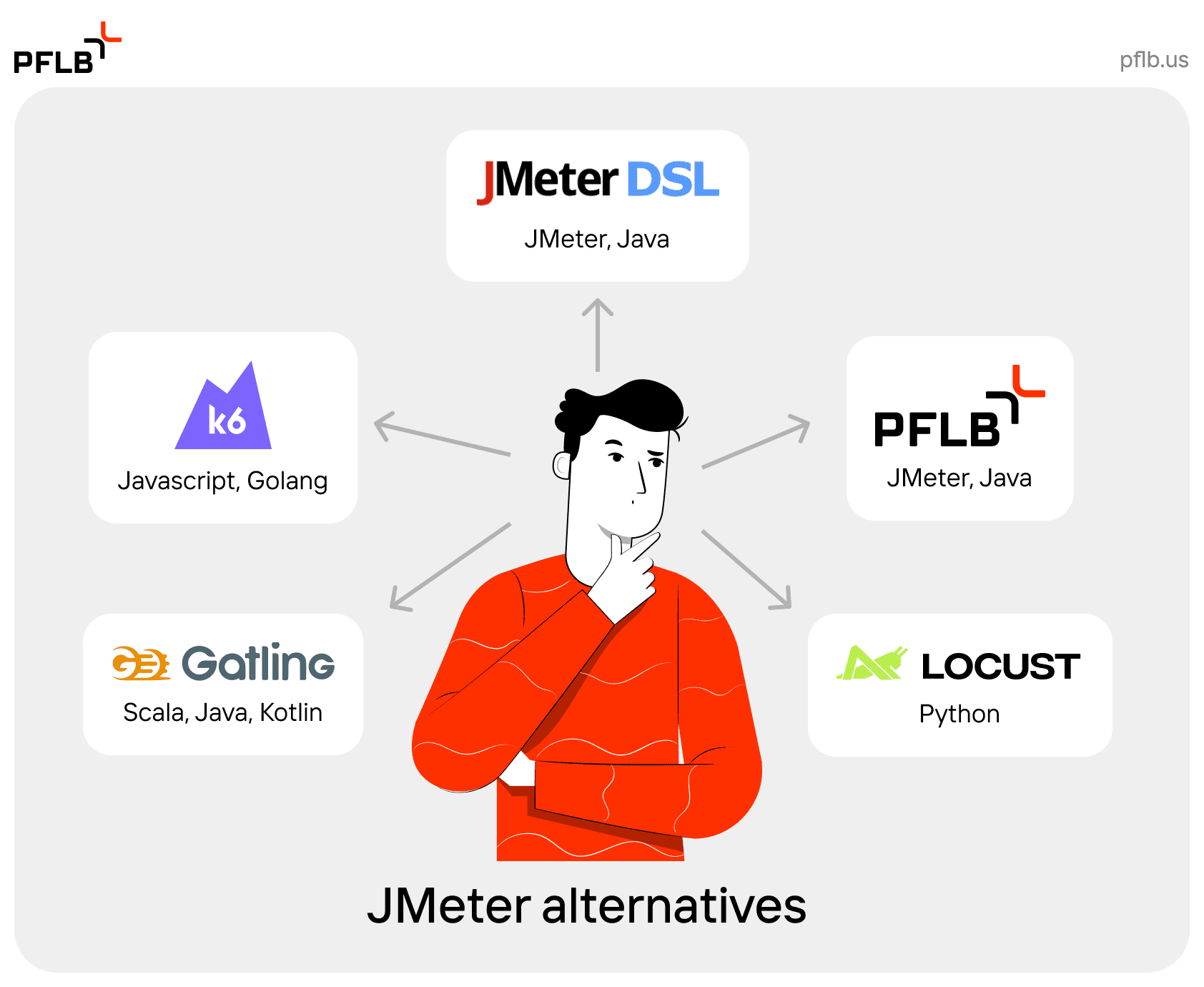It’s hard to find someone in the performance testing community who hasn’t heard of Apache JMeter. We love it for being open-source, free, feature-rich, protocol-friendly, and easily extendable. While JMeter remains a favorite, there are other tools that offer unique strengths and advantages.
This article presents a comprehensive list of the top 5 JMeter alternatives, highlighting their key features and comparisons. Whether you’re looking for advanced analytics, better scalability, or specialized protocol support, these tools provide excellent options to improve your performance testing toolkit.
Explore these alternatives to find the one that best fits your testing needs.
What Are Apache JMeter’s Weaknesses?
In 2023, the year when the tool itself turned 25 years old – 70% of organic traffic in the US related to the search for a tool for performance testing comes from JMeter, so it is still widely known and extremely popular, has many plugins and is supported for launch by various JMeter cloud load testing services (for example, PFLB, Octoperf, Blazemeter, etc.) However, as application architectures evolve to include gRPC testing framework requirements, teams are exploring specialized alternatives such as a modern gRPC load testing tool to better meet performance demands.
Despite its long history of success, JMeter isn’t without drawbacks or debatable features:
Aren’t these reasons why you should look for JMeter alternatives?
Let’s take a closer look at these solutions.
List of 5 Best JMeter Alternatives for Load Testing
PFLB
PFLB is a modern performance testing tool that can follow both a developer-centric and no-code approach. It is created as a platform to help move your JMeter load testing to either the public or private cloud. Additionally, it has several vital integrations with API and user statistics platforms. It offers an advanced REST API testing platform that helps tests be created with a test builder option straight inside your browser.
Pros
Cons
Learn more about PFLB’s JMeter cloud load testing tool.
K6 by Grafana Labs

K6 is a one of JMeter’s alternatives (learn more about K6 vs JMeter), primarily aimed at developers writing in Javascript or Go. K6 users are attracted by the ability to write tests in a familiar IDE and the ease of creating scenarios. However, in need of more complex scenarios with consequently dependent requests and advanced work with data pools, including distributed testing, then the user may encounter a lack of basic functionality. As a result, there is a need to write custom code from scratch and integrate with additional external solutions, which are often available out of the box for other tools.
Pros
Cons
Gatling
If, until a couple or triple of years ago, Gatling was a tool for geeks who write in Scala-based DSL, the tool began to gain wider popularity after support for Java and Kotlin was added. Again, the tool is made for developers who are used to writing code, so it is most suitable for such an audience. However, as it often used to be, when product users’ amounts become more prominent, some functionality previously available in the free version has been transferred to the paid version. Of course, there are workarounds, but there is no guarantee that this will not happen again.
Pros
Cons
Those, who love Gatling, say that the Scala programming language is simple for testing something unadvanced. Furthermore, in case of something more specific, connecting Java libraries and writing the code you need is more straightforward than implementing plugins with the JMeter class structure. But let’s be honest: plugin coverage in JMeter is still considerably higher (learn more about JMeter vs. Gatling vs. PFLB).
Locust
Locust is a tool that allows load testing to be performed by those who know one of the simplest programming languages - Python. It is a relatively niche JMeter alternative, but in some cases, it can be the best solution. For example, when the team only includes people who know Python, it is inevitable that the complexity of the load-testing project is small and will definitely not increase over time.
Pros
Cons
JMeter Java DSL by Abstracta

Meter Java DSL is an open-source solution that allows you to implement the Everything as Code concept, saving all Apache JMeter features underneath but considering itself as a new JMeter alternative. Old-school JMeter does not fit into the Everything As Code paradigm since scripts are created in the GUI, and its result is a JMX file in XML format, making it extremely difficult to read the code and track changes.
Therefore, the creators of this project proposed the DSL concept, which allows you to create JMeter-based scripts by writing Java code using a familiar IDE. In this approach, saving JMX files for each test is optional since they become an intermediate layer between script generation and its launch.
Pros
Cons
Who Encounters the Choice of Load Testing Tools, and in What Situations?
A switch typically happens only when there’s a serious external trigger or when critical functionality is missing and becomes essential. For example, users of JMeter rarely switch away because they’re already familiar with it. This is also why LoadRunner—once the industry standard—still holds a significant market share despite its decline in popularity.
Here are the common situations where a testing department leader must choose or replace a load testing tool:
What if you find yourself needing to choose a new tool or move away from JMeter?
Fortunately, the load testing tools market is highly competitive. Each tool has its advantages and disadvantages depending on the specific situation.
For most teams, leaving JMeter aligns with the adoption of the Everything as Code concept during product transformations. As a result, alternative tools that embrace this ideology often become the primary contenders.
In essence, the consideration of alternatives to JMeter, within the framework of this concept, has two key aspects – the programming language available to the team in the current conditions and the amount of Code that will need to be written, including for the implementation of the very functionality that is not in the box.
Consider PFLB as the Best Solution as a JMeter Alternative
PFLB emerges as the best alternative to JMeter by addressing several limitations while retaining its strengths.
PFLB makes a dedicated infrastructure unnecessary by leveraging scalable and efficient cloud-based load generation for modern distributed systems, often microservices-based architecture.
The platform also offers advanced tools for sensitive data protection, ensuring your test environments remain secure while working with production-like data.
With a user-friendly interface, robust reporting capabilities, and modern API integrations for CI/CD workflows, PFLB provides a superior experience for DevOps, SRE teams, and performance engineers seeking to elevate their testing processes beyond JMeter’s capabilities.
Conclusion
Selecting the right alternative to JMeter depends on your team’s competencies, protocol support, and automation requirements. When comparing JMeter with other solutions, understanding cloud services for JMeter load testing can provide valuable context. Tools like PFLB, Gatling, Locust, k6, and JMeter Java DSL offer unique strengths, such as AI-powered performance insights, diverse scripting options, and seamless CI/CD integration.
By exploring these Apache JMeter alternatives, teams can optimize load-testing processes and ensure their applications deliver exceptional performance under real-world conditions.
See also
Related insights in blog articles
UI Load Testing: Full Guide

When an application starts to slow down, users notice it immediately. Pages hesitate to load, buttons lag, animations freeze for a split second, and that’s often enough to make someone close the tab. These issues rarely come from the backend alone. In most cases, the real strain appears in the browser, where scripts, styles, and […]
Internet of Things Testing: Benefits, Best Practices, & Tools for Reliable Connected Systems

IoT is an ecosystem of devices connected through networks and relying on cloud or app services for endless communication, data exchange, and smart automation. For this ecosystem to work seamlessly 24/7, it heavily depends on IoT testing. Apart from impeccable performance, the latter guarantees the reliability, protection, and integrity of diverse devices, networks, apps, and […]
Swagger API Testing: What It Is, How It Works, and Best Practices for QA Teams

Testing APIs without proper documentation can feel like walking through fog — every endpoint is a guess, every parameter a risk. But not with Swagger UI API testing. Swagger turns static API definitions into a live, interactive interface where developers and QA teams can validate endpoints, check request/response schemas, and explore the system in real […]
BlazeMeter vs. JMeter: Full Comparison

Ever wondered whether you should stick with Apache JMeter or move your tests to BlazeMeter? Both tools are powerhouses in performance and load testing, but they serve different needs. JMeter is an open-source desktop tool under the Apache 2.0 license; ideal for local or distributed testing across HTTP, APIs, JDBC, and more. BlazeMeter, on the […]
Be the first one to know
We’ll send you a monthly e-mail with all the useful insights that we will have found and analyzed
People love to read
Explore the most popular articles we’ve written so far
- Top 10 Load Testing Tools for 2025: The Deep Dive Sep 9, 2025
- Cloud-based Testing: Key Benefits, Features & Types Dec 5, 2024
- Benefits of Performance Testing for Businesses Sep 4, 2024
- Android vs iOS App Performance Testing: What’s the Difference? Dec 9, 2022
- How to Save Money on Performance Testing? Dec 5, 2022


